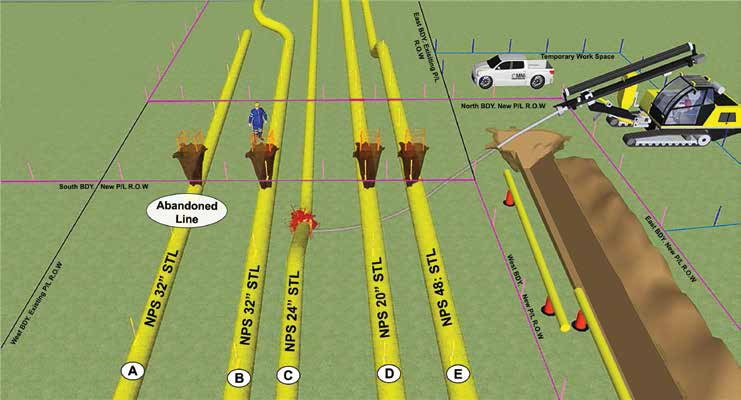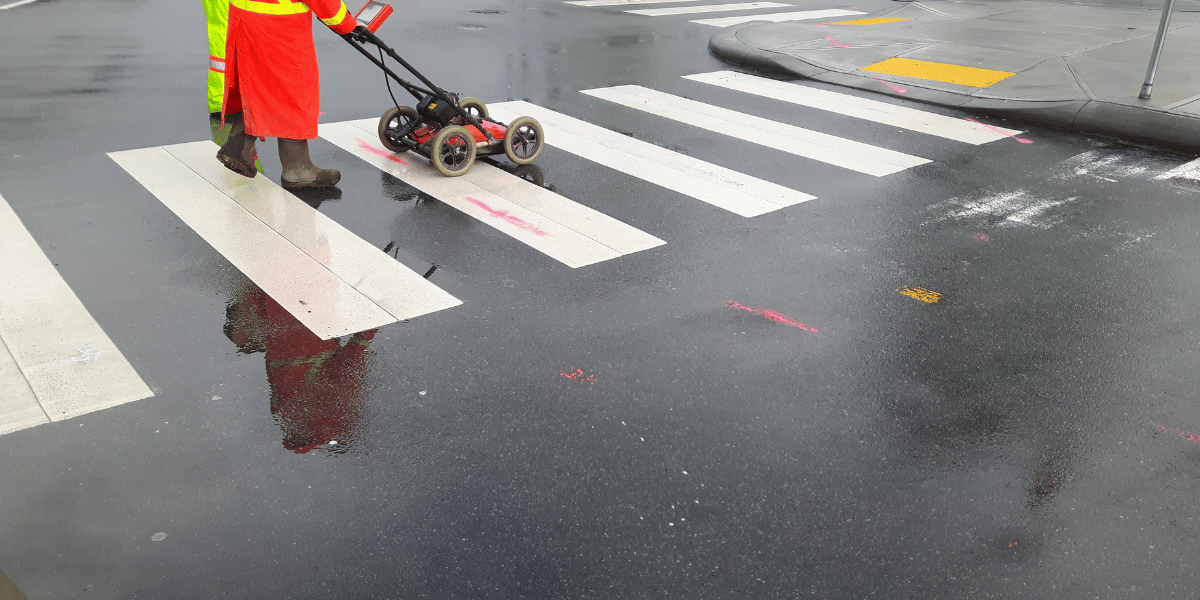
Figure 1
Placing a One Call is the most important step an excavator can take to prevent damages to underground infrastructure. However, the One Call system’s success is dependent upon active participation from its members. Unfortunately, not all infrastructure is properly maintained and located by participating members. Some infrastructure is abandoned, some is not present on inaccurate records and some is simply mismarked. In each of these cases, the location of underground infrastructure is unknown, placing excavators at great risk. Locating these “unknowns” requires a different approach than traditional, isolation locate methods.
The scenario depicted in Figure 1 (above) exemplifies the very real danger that unknown infrastructure presents. In this example, a locator has mistakenly located an abandoned pipeline instead of the intended live pipeline. The excavator then strikes the unmarked live line. It is not a reasonable expectation for excavators to avoid striking infrastructure that isn’t marked. Digging in areas containing unmarked infrastructure is like playing the board game Battleship – except nobody wants a direct hit.
This accident could have been prevented if the locator had accurate records or if a search of the area for unknowns had been performed. In places where strikes are likely to have high consequences, an excavator or project owner should consider having a search for unknowns performed, even though there are additional costs involved. Unknowns are a reality, especially in places with aging infrastructure. Even if the line struck had not been live, the excavator would have lost significant time investigating the incident and making sure it was safe to proceed.
Techniques used to search for unknowns are very different than those used to isolate individual facilities. When isolating, competent locators apply current at the lowest detectable frequency and power level, preferably using a direct connection. Current applied in this manner produces a signal that is less prone to distortion and less likely to couple or bleed off onto nearby foreign utilities. Isolation locates are successful when the target line is marked within the tolerance zone and unsuccessful when surface marks are placed outside the tolerance zone or placed in a wrong spot all together.
When searching for unknowns, the goal is not to isolate underground facilities but, rather, to discover them. The methods used are essentially the opposite of conventional locating. For example, current is often applied at high power levels and high frequencies using induction. Applying current this way creates signals that are not precise but are easily detectable. When signals are detected, a locator should revert to conventional techniques to pinpoint positions. It’s worth repeating that sweeps and scans should never be used in lieu of placing a One Call. Search locate techniques are not an effective way to isolate target lines.
Before beginning any search technique, a locator should gather information and perform a visual inspection. Information gathered may include owner/operator records, foreign utility records, historic sweep maps, photographs, legal documents, aerial imagery, etc. There is a school of thought that giving locators records will lead to confirmation bias, or is somehow giving away the answers. However, the goal of a sweep is not to test the abilities of the locator. The goal is to locate everything, and every available resource should be used. Locating or sweeping without records is much more difficult and is analogous to putting a puzzle together with the picture facing down. Successful locates begin with gathering information.
Locating or sweeping without records is much more difficult and is analogous to putting a puzzle together with the picture facing down. Successful locates begin with gathering information.
Another critical step of any locate is a visual inspection. During a visual inspection, locators are looking for aboveground features of belowground infrastructure. Markers, old marks and flagging, junction boxes, pedestals, powerline drops, changes in vegetation, and changes in pavement are some common examples. Often-times, a visual inspection will discover things that electromagnetic locating equipment cannot. For example, a weathered pipeline marker placed on an unmarked poly gathering line. When there is visual evidence, but the facility cannot be located, the excavator must be notified. Thorough visual inspections should be completed before attempting any type of locate.

Multi-angle inductive sweeps and passive scans are commonly used search techniques. These should be performed after all known infrastructure has been located and marked. A multi-angle inductive sweep requires a two-person crew. One person holds the transmitter and the other holds the receiver. The crew walks in tandem at an appropriate distance apart sweeping across the search area. The receiver and transmitter must remain in the correct orientation and be set to the same high frequency. Air coupling is prevented by maintaining an appropriate distance between the transmitter and the receiver. Typically, a crew will perform four passes at 45° alignments. Induction is usually the last resort when applying signals in a conventional locate. However, inductive sweeps are an effective search method.
Passive scans do not require a transmitter as they search for existing signals. Most modern receivers are capable of receiving live power signals, cathodic protection signals and radio signals. When performing a passive scan, the locator sets the receiver to the chosen frequency and scans the search area using a circle and grid pattern. Often, the scan will be repeated using another passive frequency. Passive locating is prone to interference and is not a good way to isolate facilities, but passive scans are an effective discovery method.

Other search methods used include sweeping with ground penetrating radar (GPR), the ALL method scan, and the parallel line check. All search methods have advantages and disadvantages. For example, a passive scan locates live or active lines well but struggles with interference. A multi-angle inductive sweep does well in green space but struggles in areas with aboveground infrastructure. An ALL scan does well in congested areas but struggles in greenspace. With proper training and experience, a locator will learn to choose the best search strategy based on site conditions.

Search methods are used to discover unknown infrastructure. Isolation techniques are used to pinpoint the location of known facilities. Dealing with abandoned, mismarked, and private infrastructure is a challenging and complex issue. Understanding that locating unknowns requires a different approach than conventional locating is an important step towards a solution. In order to prevent costly delays and reduce risks to excavators, a project owner should consider taking the additional measure of hiring professional locators to search for unknowns after the One Call process is completed.
A.J. Clark is the founder and president of Omni Damage Prevention. Omni specializes in searching for and mapping unknown infrastructure, and training people to do so. He can be reached at aj.clark@omnidamageprevention.com.


![ESM Sidebar Ad[87] ESM Sidebar Ad[87]](https://excavationsafetyalliance.com/hubfs/ESM%20Sidebar%20Ad%5B87%5D.gif)



Comments